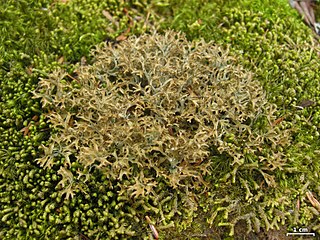
Stereocaulon paschale is a species of lichen belonging to the family Stereocaulaceae.

Stereocaulon alpinum is a species of fungus belonging to the family Stereocaulaceae. It is similar to Stereocaulon paschale but differs from it in containing cyanobacteria of the genus Nostoc while S. paschale contains cyanobacteria of the genus Stigonema, which have a darker colour than Nostoc.
Lichenopeltella santessonii is a species of lichenicolous fungus belonging to the class Dothideomycetes. It was first formally described as a new species of Micropeltopsis in 1990 by mycologists Paul Kirk and Brian Spooner. The specific epithet honours Swedish lichenologist Rolf Santesson, who collected the type specimen in Sala Municipality, Sweden, where it was growing on the foliose lichen Peltigera canina. Santesson transferred the taxon to the genus Lichenopeltella in 1993.

Muellerella lichenicola is a species of lichenicolous fungus in the family Verrucariaceae. It was first formally described as a new species in 1826 by Søren Christian Sommerfelt, as Sphaeria lichenicola. David Leslie Hawksworth transferred it to the genus Muellerella in 1979.
Lichenopeltella cetrariae is a species of fungus belonging to the class Dothideomycetes. It has been found growing on Cetraria aculeata in Hrútey near Blönduós, Iceland and on Cetraria laevigata in Bulgan district, Mongolia and Toyama prefecture, Japan. In Japan, it has also been reported growing on Flavocetraria cucullata in Yamanashi prefecture and Nagano prefecture.
Lichenopeltella uncialicola is a species of fungus belonging to the class Dothideomycetes. The species was discovered in Iceland in 2010 where it was found growing on Cladonia uncialis. Since then, it has been found on a different host species, Cladonia rangiferina, in North-Korea, Italy Austria, and Greenland.

Lichenoconium pyxidatae is a species of lichenicolous fungus belonging to the class Dothideomycetes. It has a Holarctic distribution being found in Alaska and various parts of Russia, including Siberia, Franz Josef Land, Novaya Zemlya and Wrangel Island.
Zhurbenkoa is a genus of lichenicolous fungi in the family Malmideaceae. It has three species. The genus was circumscribed in 2019 by Adam Flakus, Javier Etayo, Sergio Pérez-Ortega, and Pamela Rodriguez-Flakus, with Zhurbenkoa epicladonia assigned as the type species. Closely related genera are Savoronala and Sprucidea. The generic name honours Russian lichenologist Mikhail Zhurbenko, "for his magnificent contribution to knowledge on the biodiversity and systematics of lichenicolous fungi, including lichen parasites colonizing Cladonia".

Candelariella aggregata is a species of lichen in the family Candelariaceae. It is found in western North America, Mongolia, and Switzerland where it grows on mosses and plant debris.
Clypeococcum bisporum is a species of lichenicolous (lichen-eating) fungus in the family Polycoccaceae. It is found in the Russian Far East, in Mongolia, and from northwest Alaska, where it grows parasitically on lichens from the genera Cetraria and Flavocetraria.
Endococcus hafellneri is a species of lichenicolous (lichen-eating) fungus in the family Verrucariaceae. It is found in North Asia and the Russian Far East, Estonia, and Japan, where it grows on the lobes of the lichens Flavocetraria cucullata and Cetraria islandica.
Stereocaulon botryosum is a species of snow lichen belonging to the family Stereocaulaceae.
Stereocaulon glareosum is a species of snow lichen belonging to the family Stereocaulaceae.
Stereocaulon depressum is a species of snow lichen belonging to the family Stereocaulaceae.
Stereocaulon rivulorum is a species of snow lichen belonging to the family Stereocaulaceae.
Stereocaulon groenlandicum is a species of snow lichen belonging to the family Stereocaulaceae.
Lichenopeltella stereocaulorum is a species of lichenicolous fungus belonging to the class Dothideomycetes. It was described in 2010 from an infected specimen of Stereocaulon botryosum.
Endococcus nanellus is a species of lichenicolous fungus in the order Dothideales. It is known from Alaska, Canada, Greenland, Hawaii, Japan, Russia, South-Korea, and Kazakhstan.
Phacopsis vulpicidae is a species of lichenicolous (lichen-dwelling) fungus in the family Parmeliaceae. It was formally described as a new species in 2019 by mycologists Mikhail P. Zhurbenko and Paul Diederich. The type specimen was collected by the first author near the headwaters of Ar Khordolyn gol River in Renchinlkhümbe Somon, at an altitude of 2,050 m (6,730 ft). There, in the upper limit of a Larix sibirica forest, the fungus was found growing on the thallus of a ground-dwelling Vulpicida juniperina lichen. The species epithet vulpicidae refers to the genus of its host. Infections by the fungus cause blister-like (bullate) swellings of the host thallus. It is known to occur in arctic and mountain tundra and taiga biomes of Asia, Europe, and North America (Alaska). Its only recorded host is Vulpicida juniperina, and almost all recorded host specimens have been terricolous.

Cetraria laevigata is a species of ground-dwelling, fruticose (bushy) lichen in the family Parmeliaceae. It was formally described as a new species by Russian lichenologist Kseniya Aleksandrovna Rassadina in 1943. In North America, it is commonly known as the striped Iceland lichen.





